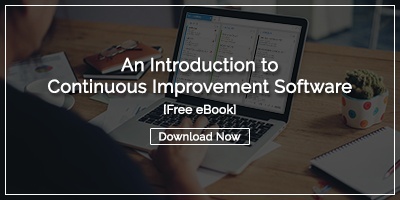The definition of opportunity cost is "a benefit that a person could have received, but gave up, to take another course of action. Stated differently, an opportunity cost represents an alternative given up when a decision is made. This cost is, therefore, most relevant for two mutually exclusive events."
Think about this in the context of opting to implement continuous improvement software. That decision is pretty clear-cut; either you implement the software, or you don't.
While people understand the concept of opportunity cost when it comes to, say, investing, applying that concept to improvement seems to be a bit more elusive.
In this post, I'd like to take a look at the opportunity cost of NOT implementing improvement software.
Typically, when we're trying to get an organization to calculate the cost of each idea they fail to capture and implement, they get stumped right off the bat because they don't know the value of their ideas and have no way to measure the numbers that are getting lost along the way.
Here at KaiNexus, we have the benefit of accessing and aggregating data from customers of all sizes from around the world at every stage of the improvement journey. Through analyzing that data, we've found that the average improvement has a financial impact of nearly $8,000 and that each person engaged in improvement averages $18,000 of impact per year. Even more significantly, we know that 1.4% of improvements have an impact of over $100,000.
When you lay it out in these terms, it's pretty easy to calculate the opportunity cost of not using improvement software; simply subtract the impact you're currently achieving from these numbers. Even more importantly, think of all the improvements that are slipping through the cracks every day you're not using software. Recognizing that each of these is worth on average $8,000 makes the need for software a little more urgent, eh?
I have to say, though, that while the financial impact is great and seems to be what a lot of organizations are focusing on, our customers recently reached a significant milestone that isn't quantified by cash, but rather, by human potential.
Last month, KaiNexus customers reached a cumulative 1 MILLION hours of time saved through their improvements in the software. This is a true testament to their dedication to improving efficiency, job satisfaction, customer and patient satisfaction, and the bottom line. Think of all that they're able to accomplish by reallocating this time to activities that actually add value to the customer!
That's a pretty abstract concept to picture, so my team and I had a little brainstorming session to exactly what humans can accomplish in a million hours.
What Can You Do with 1 Million Hours?
The average walking speed of a human is 3.1 miles per hour. In a million hours, you could walk around of the earth 124 times. With all the time people using improvement software have saved, they could walk to the moon and back six times - or around the sun once.
In one million hours, we circle the sun 114 times.
In that time, you could watch every episode of Law and Order (tied for the longest-running TV show ever) 3,000 times.
28 people could complete 4 years of medical school.
You, your dad, your grandfather, and your great-grandfather were all born.
Is the opportunity cost of failing to use improvement software becoming a little more tangible here? For me, these calculations blew my mind. Think what we could do if we were able to harness the potential in those hours saved.
A million hours is 114 years. What could we achieve with 114 years? Let's look at where we were 114 years ago to find out.
Innovation Potential in 1 Million Hours
- From the Model A to the Model 3
114 years ago, Henry Ford released the Model A, a two-seater with a max speed of 28 mph that sold for $750 and came in just one color. Now there's a waitlist a mile long for Tesla's Model 3, an all-electric vehicle which can go from 0 to 60 mph in 5.6 seconds and has a range of 215 miles. - Wright Brothers to SpaceX
Orville Wright flew the first powered plane 20 feet in the air on a beach in North Carolina, a flight which lasted just 12 seconds. In the 114 years since then, we've launched men into space, touched down on the moon, built planes that can fly Mach 6.7, and the first commercial space missions are currently taking applications. - Crayola Crayons to 3D Printers
In 1903, Crayola sold its first box of crayons. 114 years later, you can buy a 3D printer at Walmart for under $200. Today, 3D printers are used to create low-cost housing, prosthetic limbs, medical devices, and even coral reefs.
These are obviously just a few of the innovations that can be made with all that saved time. Aren't humans amazing?
So. Let's take a minute to think about this on a personal level. What could you do - what could your employees do - by saving time through process improvement? What innovations could they achieve? How could they advance your business - and the world - by spending less time on inefficiency and more time on creative improvement?
What's the opportunity cost of failing to give them the tool they need to maximize their potential?



Add a Comment